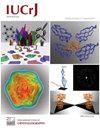推进动态量子晶体学:精确结构和热力学性质的增强模型。
IF 3.6
2区 材料科学
Q2 CHEMISTRY, MULTIDISCIPLINARY
引用次数: 0
摘要
x射线衍射(XRD)自问世以来发展迅速,成为表征材料结构的重要工具。理论,实验技术,衍射仪和检测技术的进步导致了高精度衍射模式的获取,超出了先前的预期。由于电子密度和热运动对衍射光束强度的影响,从这些图形中提取综合信息需要不同的模型。虽然电子密度模型已经取得了相当大的进步[例如Hansen-Coppens多极模型和Hirshfeld原子精化(HAR)],但热运动的处理基本上没有改变。我们开发了一种新的方法,结合了先进的电荷密度模型[非球面原子模型(AAMs),如HAR或可转移非球面原子模型(TAAM)]和热运动模型(正常模式改进,NoMoRe)的优势。我们将这种方法命名为AAM_NoMoRe,其中我们不是根据单晶x射线衍射数据改进常规的各向异性位移参数(ADPs),而是改进从周期密度泛函理论(DFT)计算中获得的频率。在这项工作中,我们通过将该模型应用于模型化合物(如丙氨酸、木糖醇、萘和甘氨酸多晶型)来证明该模型的有效性,强调了我们的方法对其adp的h原子位置和形状的影响,这与中子数据相当。我们观察到,与AAM相比,经过AAM_NoMoRe处理的h原子ADPs的相似性指数显著降低,与中子数据更接近。由于使用了非球面形状因子(AAM),我们的方法显示出更好的拟合性能,与独立原子模型(IAM)改进相比,wR2值始终较低,与传统的NoMoRe模型相比,wR2值显著降低。此外,我们提出了一个关键的热力学性质,即热容的估计,并证明了其与实验量热数据的一致性。本文章由计算机程序翻译,如有差异,请以英文原文为准。
Advancing dynamic quantum crystallography: enhanced models for accurate structures and thermodynamic properties
By implementing the aspherical atom model to normal mode refinement, we obtained accurate structures [including H-atom positions and anisotropic displacement parameters (ADPs)] and heat capacity from single-crystal X-ray diffraction data.
X-ray diffraction (XRD) has evolved significantly since its inception, becoming a crucial tool for material structure characterization. Advancements in theory, experimental techniques, diffractometers and detection technology have led to the acquisition of highly accurate diffraction patterns, surpassing previous expectations. Extracting comprehensive information from these patterns necessitates different models due to the influence of both electron density and thermal motion on diffracted beam intensity. While electron-density modelling has seen considerable progress [e.g. the Hansen–Coppens multipole model and Hirshfeld Atom Refinement (HAR)], the treatment of thermal motion has remained largely unchanged. We have developed a novel method that combines the strengths of the advanced charge-density models [Aspherical Atom Models (AAMs), such as HAR or the Transferable Aspherical Atom Model (TAAM)] and the thermal motion model (normal modes refinement, NoMoRe). We denote this approach AAM_NoMoRe, wherein instead of refining routine anisotropic displacement parameters (ADPs) against single-crystal X-ray diffraction data, we refine the frequencies obtained from periodic density functional theory (DFT) calculations. In this work, we demonstrate the effectiveness of this model by presenting its application to model compounds, such as alanine, xylitol, naphthalene and glycine polymorphs, highlighting the influence of our method on the H-atom positions and shape of their ADPs, which are comparable with neutron data. We observe a significant decrease in the similarity index for H-atom ADPs after AAM_NoMoRe in comparison to only AAM, aligning more closely with neutron data. Due to the use of aspherical form factors (AAM), our approach demonstrates better fitting performance, as indicated by consistently lower wR2 values compared to the Independent Atom Model (IAM) refinement and a significant decrease compared to the traditional NoMoRe model. Furthermore, we present the estimation of a key thermodynamic property, namely, heat capacity, and demonstrate its alignment with experimental calorimetric data.
求助全文
通过发布文献求助,成功后即可免费获取论文全文。
去求助
来源期刊

IUCrJ
CHEMISTRY, MULTIDISCIPLINARYCRYSTALLOGRAPH-CRYSTALLOGRAPHY
CiteScore
7.50
自引率
5.10%
发文量
95
审稿时长
10 weeks
期刊介绍:
IUCrJ is a new fully open-access peer-reviewed journal from the International Union of Crystallography (IUCr).
The journal will publish high-profile articles on all aspects of the sciences and technologies supported by the IUCr via its commissions, including emerging fields where structural results underpin the science reported in the article. Our aim is to make IUCrJ the natural home for high-quality structural science results. Chemists, biologists, physicists and material scientists will be actively encouraged to report their structural studies in IUCrJ.
 求助内容:
求助内容: 应助结果提醒方式:
应助结果提醒方式:


